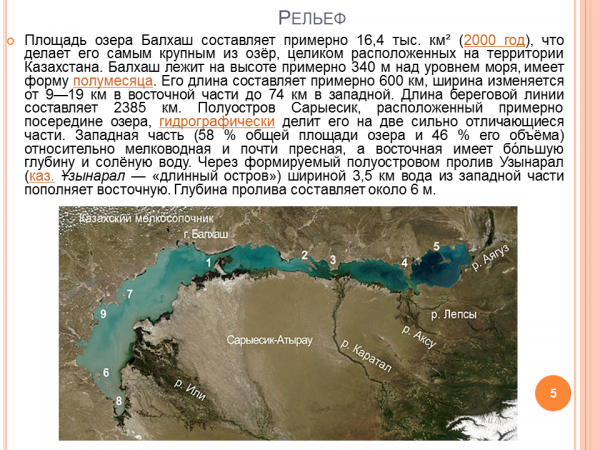
Ozero Balhash Prezentaciya
Contents • • • • • • • • • • • • • • • History and naming [ ] The present name of the lake originates from the word 'balkas' of, and which means 'tussocks in a swamp'. From as early as up until the 8th century, the Balkhash was known to the as 布谷/布库/布苏 'Pu-Ku/Bu-Ku'. From the 8th century on, the land to the south of the lake, between it and the mountains, was known in as Jetisu 'Seven Rivers' ( in ). It was a land where the nomadic and of the mingled cultures with the settled peoples of Central Asia. During China's (1644–1911), the lake formed the northwestern-most boundary of the Empire. In 1864, the lake and its neighboring area were ceded to under the.
Lake Balkhash takes 86% of water inflow from Balkhash-Alakol basin. Ili River accounts for 73–80% of the inflow with the total volume quoted as either 12.3 km 3 /year or 23 km 3 /year. The river originates in Tian Shan mountains and is mainly fed by glacier. Bring a sophisticated and modern look to your privacy room by adding this Ozeri Brezza Oscillating High Velocity Desk Fan. Ozeri Brezza 10 in. Oscillating High Velocity Desk Fan-OZF2.
With the dissolution of the in 1991, the lake became part of. The origin of the lake [ ]. The numbers mark the largest peninsulas, island and bays: • Saryesik peninsula, separating the lake into two parts, and Uzynaral Strait • Baygabyl Peninsula • Balai Peninsula • Shaukar Peninsula • Kentubek Peninsula • and Ortaaral Islands • • Shempek Bay • Saryshagan Bay The lake includes several small basins. In the western part, there are two depressions 7–11 meters deep. One of them extends from the western coast (near Tasaral Island) to Cape Korzhyntubek, whereas the second lies south from the Gulf Bertys, which is the deepest part of western Balkhash.
The average depth of the eastern basin is 16 m and the maximum depth of the eastern part (and of the lake) is 26 m. The average depth of the lake is 5.8 m, and the total volume of water is about 112 km 3.
The western and northern shores of the lake are high (20–30 m) and rocky; they are composed of such rocks as,,, and and keep traces of ancient terraces. The southern shores near the Gulf Karashagan and Ili River are low (1–2 m) and sandy. They are often flooded and therefore contain numerous water pools.
Occasional hills are present with the height of 5–10 m. The is very curvy and dissected by numerous bays and coves. The large bays of the western part are: Saryshagan, Kashkanteniz, Karakamys, Shempek (the southern pole of the lake), and Balakashkan Ahmetsu, and those in the eastern part are: Guzkol, Balyktykol, Kukuna, Karashigan. The eastern part also includes peninsulas Baygabyl, Balay, Shaukar, Kentubek and Korzhintobe. The lake contains 43 islands with a total area of 66 km 2; however, new islands are being formed due to the lowering of water level, and the area of the existing ones is increasing.
The islands of the western part include and (the largest), as well as Ortaaral, Ayakaral and Olzhabekaral. The eastern islands include Ozynaral, Ultarakty,.
Feeding the lake and the water level [ ]. Rapid ice melt on Lake Balkhash in April 2003.
Plugsound pro vst download. Balkhash-Alakol Basin covers an area of 512,000 km 2, and its average surface water runoff is 27.76 km 3/year, of which 11.5 km 3 come from the territory of China. The area of of the lake is about 413,000 km 2; with 15% belonging to the north-west of region in China and a small part in. Lake Balkhash takes 86% of water inflow from Balkhash-Alakol basin. Ili River accounts for 73–80% of the inflow with the total volume quoted as either 12.3 km 3/year or 23 km 3/year. The river originates in mountains and is mainly fed.
This results in daily and seasonal fluctuations of its water level with a strong increase during the glacier melting season in June–July. The river forms an extended which covers the area of 8,000 km 2 and serves as an accumulator, providing water in the drought years. The eastern part of the lake is fed by the rivers, and, as well as. The Karatal River originates on the slopes of and is the second largest water source for the lake. River, which fed the eastern part of the lake until 1950, barely reaches it nowadays. The annual difference in the flow to the western and eastern parts of the lake is 1.15 km 3. Water balance of the lake in 2000 Total inflow to the lake was 22.51 km 3, including: • Surface water – 18.51 km 3, • Underground water – 0.9 km 3, • Sediments and ice – 3.1 km 3.